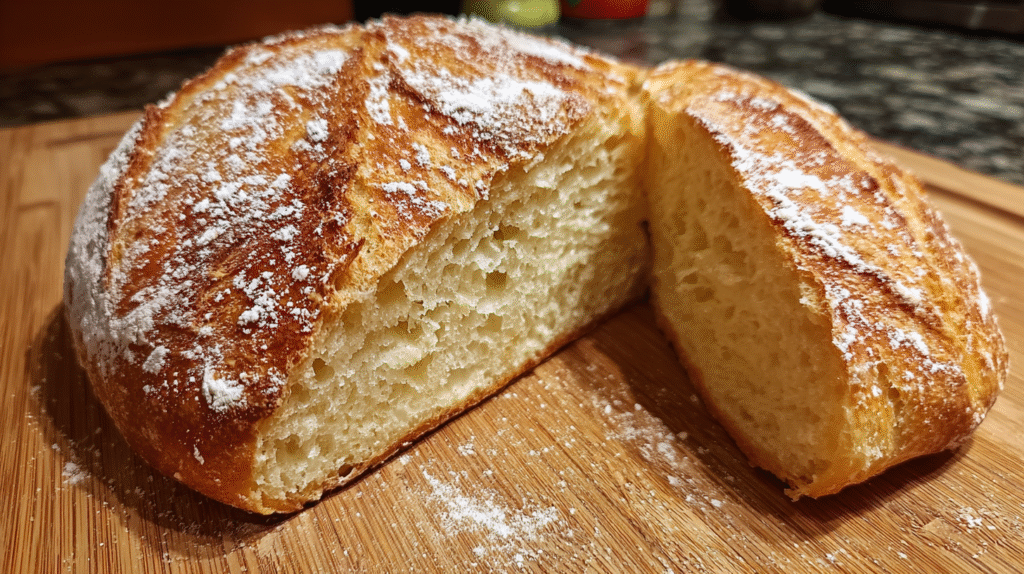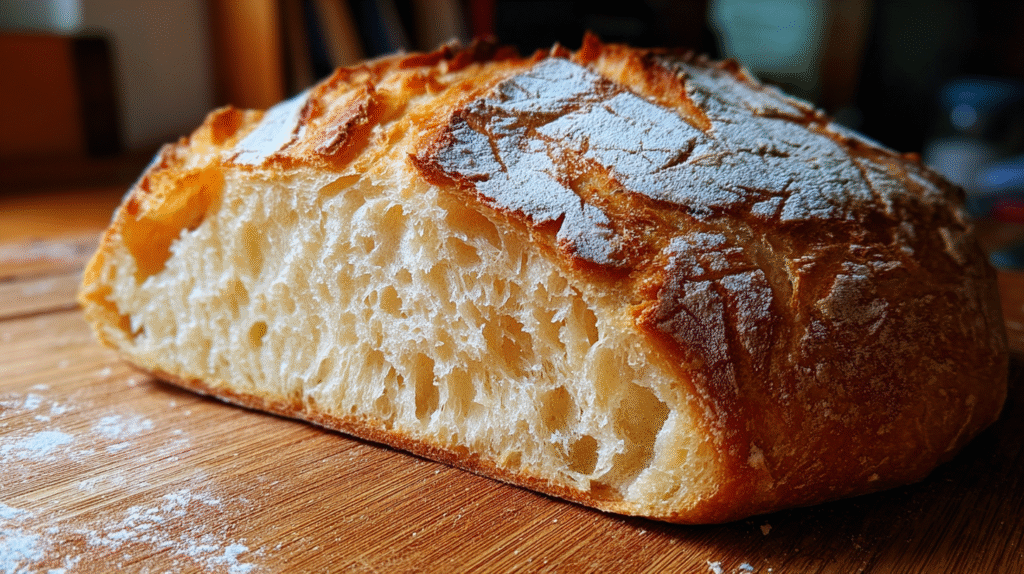Craving fresh bread on a low carb diet but dreading the mess and effort of traditional kneading? This moist yogurt bread changes everything. It comes together in one bowl, requires zero kneading, and delivers that soft, tender crumb you’ve been missing since cutting carbs.
I’ve tested this recipe dozens of times in my own kitchen, and it’s become my go-to solution for sandwich bread, toast, and those moments when only real bread will do.

Why This No-Knead Yogurt Bread Works
The secret lies in the yogurt. Greek yogurt adds moisture, protein, and fat that keeps this bread incredibly soft for days. Unlike many low carb breads that turn dry and crumbly within hours, this one stays tender.
The no-knead method works because we’re using alternative flours that don’t develop gluten the same way wheat does. There’s nothing to develop, so kneading becomes unnecessary. You simply mix, pour, and bake.
Essential Ingredients for Perfect Results
Almond Flour (2 cups) Use blanched, finely ground almond flour. The blanched variety gives you a lighter color and better texture. Bob’s Red Mill and Anthony’s consistently deliver good results.
Greek Yogurt (1 cup) Full-fat Greek yogurt is non-negotiable here. It provides the moisture and richness that makes this bread special. I’ve tried low-fat versions, and they create a denser, drier loaf.
Eggs (4 large) Eggs provide structure and help the bread rise. Use room temperature eggs for better incorporation into the batter.
Baking Powder (2 teaspoons) This is your leavening agent. Make sure it’s fresh. Old baking powder won’t give you the lift you need.
Psyllium Husk Powder (3 tablespoons) This ingredient mimics gluten’s binding properties. It holds everything together and creates a bread-like texture. Don’t skip it.
Apple Cider Vinegar (1 tablespoon) The acid reacts with the baking powder for extra lift. It also helps neutralize any eggy flavor.
Step-by-Step Instructions
Prep Your Pan Line a 9×5 inch loaf pan with parchment paper. Make sure the paper comes up the sides for easy removal. Grease it lightly with butter or coconut oil.
Mix the Dry Ingredients Combine almond flour, psyllium husk powder, baking powder, and a pinch of salt in a large bowl. Whisk them together thoroughly to break up any clumps.
Blend the Wet Ingredients In another bowl, whisk together eggs, Greek yogurt, and apple cider vinegar until smooth. The mixture should be completely uniform with no yogurt lumps.
Combine and Rest Pour the wet ingredients into the dry ingredients. Stir with a spatula until just combined. The batter will be thick, almost like cake batter.
Let it rest for 5 minutes. The psyllium husk needs this time to absorb moisture and thicken the batter.
Bake to Perfection Pour the batter into your prepared pan and smooth the top. Bake at 350°F (175°C) for 50-60 minutes.
The bread is done when a toothpick inserted in the center comes out clean and the top is golden brown. Internal temperature should reach 200°F.
Cool Completely This step matters more than you think. Let the bread cool in the pan for 10 minutes, then transfer to a wire rack.
Wait at least 1 hour before slicing. Cutting into warm low carb bread leads to gummy texture and crumbling.

Getting That Perfect Moist Texture
Temperature matters. Room temperature ingredients blend more smoothly and create a better crumb structure.
Don’t overmix the batter. Once the wet and dry ingredients come together, stop stirring. Overmixing can make the bread dense.
The yogurt-to-flour ratio creates moisture. If your bread turns out dry, you might be measuring flour incorrectly. Spoon it into your measuring cup rather than scooping directly.
Store the bread properly. Keep it wrapped in plastic wrap at room temperature for 2 days, or refrigerate for up to a week. The yogurt keeps it moist even when chilled.
Nutritional Breakdown Per Slice
Based on 12 slices per loaf:
- Calories: 145
- Net carbs: 3.5g
- Protein: 7g
- Fat: 11g
- Fiber: 3g
This bread fits perfectly into keto, low carb, and diabetic-friendly meal plans. The high protein content keeps you satisfied longer than regular bread ever could.
Flavor Variations to Try
Garlic Herb Bread Add 2 teaspoons garlic powder, 1 teaspoon dried oregano, and 1 teaspoon dried basil to the dry ingredients. Mix in 2 tablespoons fresh chopped parsley before baking.
Seeded Multigrain Style Fold in 2 tablespoons each of sunflower seeds, pumpkin seeds, and flaxseeds. Press extra seeds on top before baking for a rustic look.
Sweet Cinnamon Bread Add 2 teaspoons cinnamon and 3 tablespoons of your preferred low carb sweetener. Swirl in some sugar-free cinnamon filling before baking.
Everything Bagel Bread Top the batter with 3 tablespoons of everything bagel seasoning before baking. This creates an incredible savory breakfast bread.
Common Mistakes and How to Fix Them
Bread Won’t Rise Check your baking powder expiration date. Old leavening agents lose potency. Also ensure your oven temperature is accurate. Most ovens run hot or cold.
Too Dense and Heavy You might be packing the almond flour too tightly when measuring. Fluff it up first, then spoon into your measuring cup.
Not enough eggs can also cause density issues. Make sure you’re using large eggs.
Crumbly When Sliced This usually means not enough psyllium husk or cutting the bread while still warm. Always let it cool completely and consider adding an extra tablespoon of psyllium husk.
Eggy Taste The apple cider vinegar should neutralize this, but if it’s still present, add 1 teaspoon of vanilla extract. A pinch of cream of tartar also helps.
Storage and Freezing Tips
Room temperature storage works for 2-3 days when wrapped tightly in plastic wrap. Keep it away from direct sunlight and heat sources.
Refrigerator storage extends life to 7 days. Wrap individual slices in plastic wrap, then place in an airtight container. Toast slices straight from the fridge for best texture.
Freezing is your friend. Slice the entire loaf, wrap each slice individually, and freeze in a freezer bag for up to 3 months.
Toast frozen slices directly in the toaster. No thawing needed. This method gives you fresh-tasting bread anytime.
Serving Suggestions
Breakfast Ideas Toast it and top with avocado, eggs, and everything bagel seasoning. Or spread with cream cheese and smoked salmon for a bagel-style breakfast.
Make French toast using this bread. It holds up beautifully to the egg mixture and creates a low carb breakfast that tastes indulgent.
Lunch Options This bread makes excellent sandwiches. The sturdy texture holds up to wet ingredients without getting soggy.
Try it with turkey, bacon, lettuce, and mayo for a classic club. Or make a grilled cheese that actually crisps up properly.
Dinner Pairings Serve alongside soups and stews. It’s perfect for soaking up every last drop.
Use it for bruschetta. Toast slices, rub with garlic, and top with fresh tomatoes and basil.
Why Yogurt Makes All the Difference
Traditional low carb breads often rely solely on eggs and cheese for moisture. They work, but they lack the tender crumb of real bread.
Yogurt brings acidity that tenderizes. It also adds beneficial probiotics and extra protein without significantly increasing carbs.
The fat in full-fat Greek yogurt coats the protein molecules in almond flour. This creates a softer, more cake-like texture that regular low carb breads can’t match.
Yogurt’s moisture content stays locked in during baking. The bread doesn’t dry out as it cools, which is why day-two slices taste just as good as fresh.
Equipment You’ll Need
A 9×5 inch loaf pan is standard. Metal pans create better browning than glass or ceramic.
Parchment paper prevents sticking and makes cleanup easier. Don’t skip this step.
A large mixing bowl and whisk handle the mixing. No stand mixer or special equipment required.
A digital kitchen scale helps with accuracy if you want consistent results every time. Almond flour can vary significantly by volume measurement.
Troubleshooting Texture Issues
Too Moist or Gummy Center Your bread might not be fully baked. Low carb breads can look done on the outside while remaining raw inside.
Always use a thermometer. The internal temperature should reach 200°F. If it looks too brown before reaching this temperature, tent with foil and continue baking.
Top Cracks Deeply This is actually normal for this type of bread. The crack forms as the bread rises and the top sets.
If it bothers you, score the top with a knife before baking. This controls where the crack forms.
Sinks in the Middle Opening the oven door too early causes this. Don’t peek before 45 minutes of baking time.
Overmixing can also create this issue. The batter gets too much air that deflates during baking.
FAQ Section
Can I use regular yogurt instead of Greek yogurt? Regular yogurt has too much moisture and not enough protein. It will make your bread soggy and prevent it from setting properly. Stick with full-fat Greek yogurt for best results.
Is this bread suitable for a keto diet? Yes. With only 3.5g net carbs per slice, this bread fits well within most keto macros. Just watch your portion sizes and account for toppings.
Can I make this bread dairy-free? You can substitute coconut yogurt for Greek yogurt. Look for unsweetened, full-fat varieties. The texture will be slightly different but still good.
How do I know when the bread is fully baked? Use a toothpick or cake tester inserted into the center. It should come out clean with no wet batter. The internal temperature should read 200°F on a digital thermometer.
Why is my bread dense instead of fluffy? Check your baking powder freshness first. Also ensure you’re not packing the almond flour when measuring. The batter should be thick but pourable, not stiff.
Can I use coconut flour instead of almond flour? No, coconut flour absorbs liquid completely differently. You’d need an entirely different recipe. These flours are not interchangeable.
Does this bread taste eggy? When made correctly with apple cider vinegar, it shouldn’t. If you’re sensitive to egg flavor, add 1 teaspoon vanilla extract to mask it further.
Can I add cheese to this recipe? Yes. Fold in 1/2 cup shredded cheddar or parmesan at the end. It adds flavor and extra fat without affecting the texture significantly.
How long does this bread stay fresh? At room temperature, 2-3 days. Refrigerated, up to a week. Frozen, up to 3 months. The yogurt keeps it moister than typical low carb breads.
Can I double this recipe? Yes, but bake in two separate loaf pans. Doubling the recipe in one large pan will cause uneven baking and a raw center.
Final Thoughts
This moist low carb yogurt bread proves you don’t need to sacrifice texture or convenience when eating low carb. The no-knead method takes the intimidation out of bread baking, while the yogurt ensures every slice stays soft and delicious.
Whether you’re making sandwiches, toast, or just want a slice with dinner, this recipe delivers. Mix it in one bowl, bake it once, and enjoy homemade low carb bread all week long.
The best part? You’ll actually look forward to making it again.
